
Trotec has worked hard to demonstrate how investing in a laser engraving system could help open up new fields of business
In the summer of 1979 whilst at college studying graphic design I took a
summer job at Maggs Engraving in Highbridge in Somerset. The main bulk
of the work was engraving with small hand controlled machines inscribing
brass plaques for solicitors and doctors or engraved plastic substrates
for machine labels. The range was limited but then so were the types of
machinery and materials —and that according to today’s engravers are
the biggest changes.
So, with that in mind, is it still a sector worth diversifying into and
making an investment into the equipment, materials, training, and sales
facilities needed to make a go of it? The short answer is ‘yes’, it is
worth your serious consideration given the ongoing popularity of shows
such as Euro Trophex and the ongoing buoyancy of this market segment in
the UK. The longer answer though is of course below, and it largely
depends on what your ambitions are, and what level of profit you will be
satisfied with by moving into this sector.
From hand to lasers
Martyn Wright of Brunel Engineering in Clevedon in North Somerset has
been in the industry since the late 1960s and has seen the changes made
with new materials and new kit. However, he says in one sense the
industry at its core has not changed. He explains: “Engraving hasn’t
really changed since it was done by hand. Basically it is the removal of
metal or material from a surface that creates an image in whatever
shape or form it is.

Engraving hasn’t really changed since it was done by hand”
“Where that can go really is up to the new materials and the machines
that are being developed. Engraving was always done by hand and then it
changed to the use of manual engraving machines. After that computer
control came in, where the software is connected to the engraving
equipment, which has increased the possibilities. Now we are moving onto
chemical etching and laser engraving. The next step maybe could be into
fibre lasers, which will actually cut into metal.
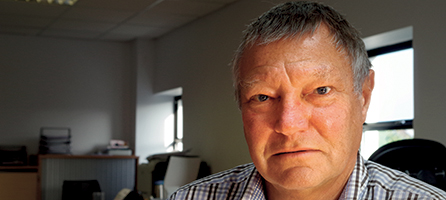
Martyn Wright of Brunel Engraving in North Somerset has been in the industry since the 1960s and has seen all the innovations in engraving
“Years ago the materials were always brass and aluminium. Then in came
stainless steel and the machines became more durable so they could
engrave into this tougher material. The plastics were always the rigid
engraving laminates such as Traffolyte, after that came out there were
the flexible engraving laminates, which gave us a much greater spread of
colours and finishes.
“The most recent material is Corian, which the public know as a seamless
kitchen surface that can be used to form sinks and worktops. What we do
is to utilise the stone finishes in Corian and we create a product from
it. It comes in a granite finish, a slate finish, and all sorts of
textured surface finishes. What we have done is to take it a stage
further and insert full colour images into it as well as engrave it. We
utilise wide-format printing, acrylics, and traditional engraving
methods to give us the finish we require.”
Old techniques
The use of Corian is clearly a long way from the stone engravers of the
classical past and the trophy etchers of yesteryear, although as Martyn
Wright points out the techniques are still essentially the same. With
new computer controlled equipment and a host of new materials, a whole
new world of possibilities has opened up.
At Kings Plastics in Bristol, another aspect of engraving has been
pioneered that takes the basic essential of the art and gives it a
modern LED twist. Will Stapleton of the firm, based in the city’s Old
Market area, says they still do a large amount of traditional brass and
metal plaque work along with control panels for machinery, but edge lit
engraving has become a big part of their operation.
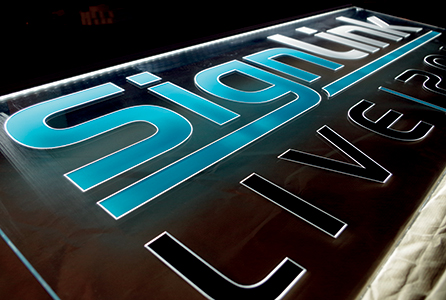
Made by Kings Plastics of Bristol, an engraved edge-lit sign using Perspex and LED lighting, and an infill of coloured substrate, creates a bright, sharp, and modern look
He explains: “Edge lit is a form of engraved sign we specialise in using
our edge lit system to illuminate panels, which we have engraved on the
back using a traditional technique but in a new way. Rather than
engraving something and filling it in so you can’t see it, the whole
point of an edge lit sign is to engrave it so you can see it.
So, you are cutting into the back of the panel so the light hits the
engraving in the panel and that’s the whole essence of an edge light.”
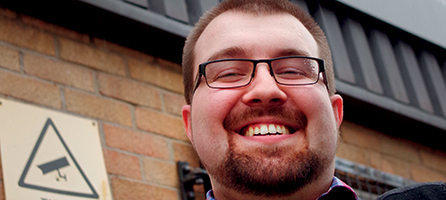
Will Stapleton of Kings Plastics says the world of engraving has gone through a revolution in materials, machinery, and techniques
Kings Plastics feature a wide range of sign-making techniques that
encompass built-up letters and large graphics, shop and retail signage
as well as the more traditional end of engraving, but edge-lit is seen
as a new direction.
“Edge lit signs are used by anyone and everyone,” says Will Stapleton,
adding: “They are really good for office faced businesses. When you walk
into an office reception the first thing you want to see is a really
big illuminated version of their logo. If the company are sharing their
office block then they may not be able to have their signage outside so
they need something inside that is really eye-catching and really
special and that’s what the edge light brings.”
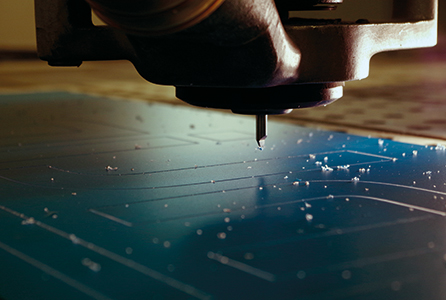
Kings Plastics’ engraver beavers away creating an edge-lit sign
So, with that left of field application of this sector’s technology now
covered, it is worth looking at a firm that could let you diversify into
this sector without having to stump up a lot of capital investment.
Brunel Engraving may in some ways be seen as a traditional engraving
firm, but their work has taken engraving to new markets unheard of a few
decades ago. They have engraved Tudor markings into Shakespeare’s
garden in Stratford-upon-Avon to mark the anniversary for the bard last
year and their use of Corian has been put to use in war memorials,
street furniture, and to support, and as part of, public works of art.
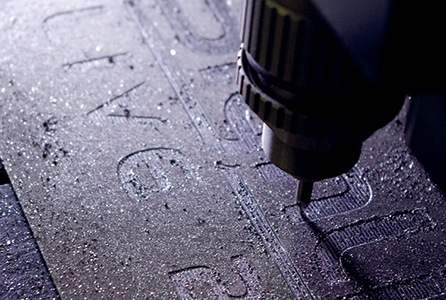
Stainless steel automated engraving taking place at Brunel Engraving
Martyn Wright of the firm comments: “I started in the business in 1967, I
studied with Taylor Hobson the precision engineers who made a range of
engraving machines. I was with them to demonstrate the engraving
machines, and then on servicing as well. The basic principle of
engraving is creating a mark in a piece of material and filling it with
paint, and it hasn’t really changed other than the materials that we are
using. It’s the materials and the equipment that has changed.”
Down to earth
On that prosaic note, Bill Gailey writing on an American engraving forum
says customers are not bothered about how engraving is achieved, they
only want the finished product to be right. He says: “I bought my first
laser in February 1982, an 80 watt engraver. Since then I have owned
three different machines. When I started 30 years ago all we could laser
was wood plaques, acrylic, stone, and glass. I have watched the
supplier side of the industry create literally thousands of new products
that can be engraved using a laser.
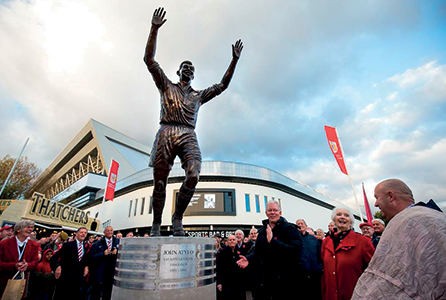
Bristol City FC’s John Atyeo is celebrated with a statue with traditional engraving on the base by Brunel
“The only way lasers will become obsolete in our lifetimes is if we stop
thinking and designing creative solutions for our customers. Every day I
find another idea on the forum that allows me to create something I
have never made before and that leads me to completely new possibilities
for my customers.”
Laser possibilities
Kings Plastics are also well used to innovation with laser engraving.
Will Stapleton comments: “One thing we have done before and we are
looking into is the introduction of laser cutters. We’ve now started
laser engraving as well as generic sort of router, and specific
engraving machines using those instead.
“Using things like software programmes in order to convert images into a
block file for the laser engraver, so it’s not just a case now of if
you’ve got a picture you have to sandwich between two panels. Using the
laser engraver you can engrave it straight onto the back of the panel
and then you get it engraved. Obviously we can make it negative either
way, so we can engrave any image straight onto the Perspex panel, as
long as the image quality is good enough.”
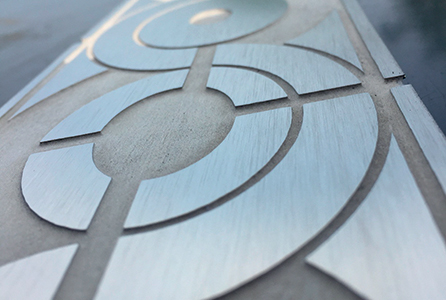
Tudor decoration engraved to mark Shakepeare’s 300th anniversary in 2016 by Brunel Engraving
So, what have the new techniques, materials, and machinery replaced?
What types of engraving that I learnt to use in the 1970s on those
rather primitive machines during my summer holiday have been replaced by
the new wave? I turned to Will Stapleton again to ask what, for
instance, edge-lit engraving has replaced. He replies: “Edge-lit
engraving has replaced in most cases big bulky light boxes located in
offices, which were not the greatest thing to look at in the world.
Also, I think there’s a small possibility that it could and has in some
cases replaced the old glass neon.”
LED has certainly eaten into the market once dominated by neon. The
strips of mini lights are now so small and flexible they can be inserted
into the most constrained of spaces, meaning the engraved surface is
beautifully lit. In short, the style is quite dramatic.
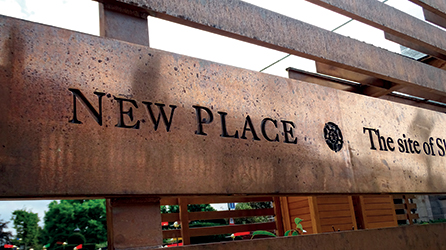
Engraving to take the weather by Brunel at Shakespeare’s birthplace
“It is changing all the time and we are always trying to keep up with
trends,” says Will Stapleton, who adds: “Last year we launched a whole
new range of LEDs. We started to keep up with other trends using
different lenses and colours and that sort of stuff so LEDs are leading a
revolution but it is changing constantly and we try to keep up with
it.”
On the cutting-edge
Now, another important decision when considering how to get into etching
and engraving is of course what technology is on offer and whether its
price tag can be recovered and generate new income streams. Now, the UK
and Europe is spoilt for choice when it comes to equipment suppliers,
just look at the advertising pages in the back of SignLink to give you
an idea.
One in particular that has done well to establish a solid market share
and offers some impressive technology is Trotec, which specialises in
laser engraving systems: “In essence a laser cutter provides friction
free cutting of materials by way of vaporising the sign substrate with
the laser beam, this means there's no necessity to clamp the workpiece
to the table, and as a consequence productivity is increased and sheet
materials can be cut right up to the edge, maximising profit from each
and every sheet processed,” explains Andrew Campling, sales manager of
Trotec.
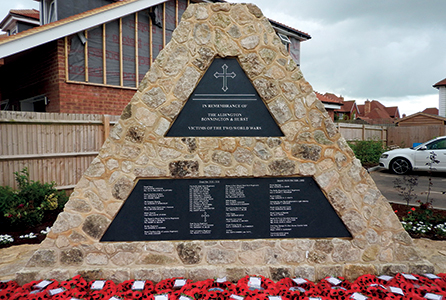
Corian used by Brunel in this sensitive piece of engraving at a war memorial
To further productivity and with true Austrian efficiency, the lasers
have bi-directional feedback from PC to laser, allowing jobs to be
quickly and efficiently started.
A chief benefit of lasers is the simplicity in creating cut paths; with a
spot size at around just 0.1mm diameter, signs can be created without
complex offsetting of tool paths, which is necessary when using a
conventional router. To sum up, sign-makers with lasers have the ability
to produce more complex and interesting designs, with faster set up and
easier work handling when compared to conventional routing.
With the growth of print and cut products Trotec lasers can be fitted
with a digital camera, making it possible to pick up on registration
marks in order to accurately cut contours. This is a major growth area
for many of our sign customers and from printed signage it is easy to
port the process into point of sale and digital print media, providing
yet another opportunity for expansion.
“Our network of showrooms allows us to be much more than a shop window
for our customers, upskilling and open events are run regularly,
allowing customers to develop the skills they need to build on the
lasers capabilities, and offering scope for expansion,” continues
Campling.
He adds: “Last but no means least, any business supplying machinery is
only as good as its service and technical support, and being a
subsidiary of the Austrian-based company, our customers have the benefit
of being supported directly by the manufacturer. Technical support is
run from our headquarters in Washington Tyne and Wear, where customers
can access our technical managers for hardware and software support
during office hours.
We made a huge investment in training our team of regionally based
engineers with the regional showrooms providing materials and
application based support.”

Last but no means least, any business supplying machinery is only as good as its service and technical support”
Speaking to engravers and seeing the type of work they now do showcased
on their websites reveals a dramatic change in the industry since my
days as an engraver in the 1970s. Corian and other substrates have come
to replace stone in many places while plastics have multiplied in a
variety of strengths, colours, and flexibility. Merging photographs with
engraved surfaces and imagery of all types, and a vast range of fonts
has brought new graphics to the art of the engraver. Computer software
and the way they link to the machinery has also seen a revolution with
new possibilities for graphic designers.
O Factoid: The first evidence for humans engraving patterns is a chiselled shell in Java, Indonesia, engraved by Homo Erectus humanoids 500,000 years ago. O
The future seems to be a further widening of the commercial aspects of
engraving from trade shows, demonstrations, directional signage, and
information graphics that need to stand up to the weather. And the
domestic market is set to boom as people want special engraving for
weddings and major life celebrations as one offs. It is certainly a
whole new world compared to that rather more basic field of engraving I
experienced back in 1979.
Your text here...
Your text here...